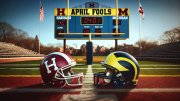Declaring that “Today will be a significant day in college sports history,” the Ivy League and the Big Ten announced that they would merge, effective in the 2025-26 academic year, and that the conference will institute relegation.
According to the blockbuster April 1 agreement, the eight Ivy schools—Brown, Columbia, Cornell, Dartmouth, Harvard, Penn, Princeton, and Yale—will join the 18 schools of the Big Ten (which next season will include former Pac-12 schools Oregon, Washington, Southern Cal, and UCLA) to form a coast-to-coast superconference. The Ivy schools will be permitted to offer athletic scholarships, reversing a policy that has been in effect since the league began play in 1956. Other changes in policy will include graduate students being eligible to participate on current Ivy teams, and Ivy teams being able to compete in football’s postseason, including the national championship series.
“This is huge,” said Tim Murphy, who recently retired after 30 seasons coaching Harvard football. “Postseason football was always the line in the sand for the Ivy schools, symbolizing our different stance on the sport.”
The merger is the latest, and most startling, instance of conference realignment that is remaking college sports. “Like the Soviet Union, the Ivy student-athlete model had a lifetime of seven decades,” said Robin Harris, executive director of the Ivy League. “But with all the recent changes in college sports—such as rulings allowing compensation for use of name, image, and likeness, and new rules regarding transfers—our presidents, A.D.s, coaches, student-athletes and alumni felt as a body that we were losing ground. As we have watched TV revenues rocket upward, particularly for football and men’s and women’s basketball, we decided that we owed it to our schools to re-enter the major college-sports arena.”
CBS, Fox, and NBC hold rights to broadcast Big Ten football games in a seven-year deal estimated at $7 billion. In 2021-22, the most recent year for which figures are available, Ohio State topped the conference, receiving $71.92 million from conference distributions, media rights, and postseason football. The school with the lowest distribution, Rutgers, reported $49.21 million. “We could not ignore the financial inducements offered by a return to big-time football,” said Harris. “We have iconic brands in major TV markets. Ivy football again will be a hot commodity. Our stadiums will be filled. Once again, we will be bowl-eligible. Once again, we will be in the football national championship picture.”
“We are thrilled to be allied with such prestigious universities,” said Tony Pettiti, commissioner of the Big Ten. “The Ivies and the Big Ten are a great fit, geographically as well as academically.” Pettiti predicted that “in five years the Penn-Penn State rivalry will be one of the five biggest in college football.”
Ivy League schools have been competitive in several major sports, even winning national championships in ice hockey and lacrosse. Football is the sport needing the largest upgrade. In the game’s early days, the future Ivy schools were preeminent football powers, with Yale, Princeton, and Harvard often being named national champions. Four future Ivy teams (Brown in 1916, Penn in ’17, Harvard in ’20, and Columbia in ’34) played in the Rose Bowl, while three early Heisman winners (Larry Kelley and Clint Frank of Yale in 1936 and ’37, respectively, and Dick Kazmaier of Princeton in ’51) came from future Ivy schools. But beginning in the mid-1950s and continuing to the present, the gap between Ivy football and the major college version has become a chasm. The last Ivy team to be nationally significant in the major-college rankings was Dartmouth’s 1970 squad, which finished its season No. 14.
Although many of the Ivy football stadiums are small or recently have been downsized, Harris said that financial campaigns will kick off at each school to rebuild and enlarge them. Likewise, so-called “collectives” will be activated to raise funds earmarked for enhanced student-athlete compensation. Reportedly the going rate for a Big Ten-worthy quarterback is $1 million and up. Harris is unfazed. “Our alumni have the deepest pockets in the world,” she said. The Ivy schools also will loosen academic standards to recruit student-athletes who otherwise would not qualify. As Erin McDermott, the Nichols Family director of athletics at Harvard, put it, “For certain applicants, we will focus more on their times in the 40 and their reps in the weight room than on their GPAs.”
A novel feature of the merger will be relegation—akin to that in European soccer. In ’25-26 there will be three divisions: two from the Big Ten, and a third containing the Ivy schools, which will be named the Teevens Division, in honor of late Dartmouth coach Buddy Teevens. At season’s end the three top Ivy finishers will move up to the Big Ten for the following season’s play, while the Big Ten’s three bottom finishers will drop down to the Teevens. “This certainly will make those late-season games between, say, Maryland and Northwestern more exciting,” said Pettiti.
At least two Ivy coaches have history with their new foes. Tommy Amaker, Harvard’s men’s basketball coach, previously coached at Michigan. And Andrew Aurich, the Crimson’s new football coach, spent the past four seasons as the tight ends coach at Rutgers. When told that the merger was official, Aurich joked, “I thought I was through with those big dummies from Ohio State.” Turning serious, he added, “We’ll show up. I can’t wait for us to play in Michigan’s Big House, and for the Wolverines to come into the Stadium. Bring ’em on!”









